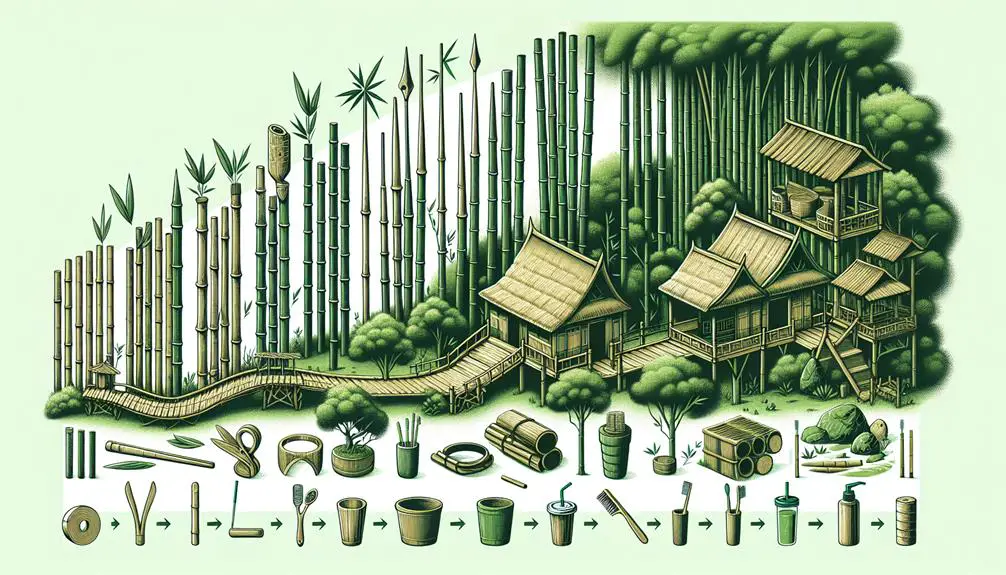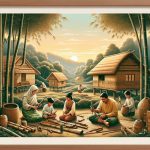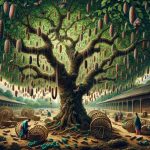Did you know bamboo started out in China over 7,000 years ago? It's pretty wild! Since then, folks have been using it for everything from treehouses to serious building materials across Asia. It's not just any plant; in many Asian cultures, bamboo stands for strength, flexibility, purity, and a bunch of other cool virtues. People even made tools, musical instruments, and religious items from it. Heck, it was so key to daily life that it even popped up in some gorgeous ancient art pieces! Bamboo has a lot more stories to tell, just waiting to be uncovered.
Table of Contents
Key Takeaways
- Bamboo originated in China over 7,000 years ago, becoming essential in daily life and culture.
- It was used for building treehouses in ancient China over 5,000 years ago.
- Throughout the Ming and Tang dynasties, bamboo played a significant role in both practical uses and luxurious interior designs.
- Symbolically, bamboo represents strength, flexibility, and resilience across various Asian cultures, including China, Japan, and India.
- Bamboo has been utilized in religious practices, serving as material for constructing temples, making prayer beads, and symbolizing purity and simplicity in Buddhism.
Early Origins and Spread
Bamboo first popped up in China over 7,000 years ago, and it quickly became a big deal for all sorts of uses. I mean, imagine this super versatile plant just waiting to be discovered and used by the Chinese people. They didn't just admire it; they built their lives around it. Over 5,000 years ago, folks were already crafting treehouses out of bamboo. That's not just any old woodwork; it's innovative, eco-friendly architecture way ahead of its time.
The spread of bamboo wasn't just a local affair, either. Its fame as a prime building material shot across various regions, showing up everywhere. People didn't just use it for homes; they used it for feeding livestock, making sturdy tools, and so much more. It's like bamboo was the Swiss Army knife of the plant world.
Diving into the history books, you'll see bamboo all over the place. From the Ming to the Tang dynasty, this plant wasn't just about utility. It was a part of life, shaping how the Chinese people built and lived. Seriously, the history of bamboo isn't just about growth; it's about innovation and survival.
Cultural Significance in Asia
Bamboo isn't just a plant in Asia; it's a powerful symbol that's been around for ages, showing off strength and flexibility.
From ancient artworks to modern buildings, it's clear bamboo plays a huge role across many parts of Asian life.
I'm excited to explore how bamboo's been used in art, its symbolic meanings, and its cool new uses today.
Ancient Bamboo Symbolism
Throughout Asia, countless traditions celebrate bamboo as a symbol of strength, flexibility, and resilience. For example, in China, bamboo isn't just a plant; it's a vital part of the culture, representing longevity, prosperity, and purity. It's fascinating how these meanings are woven into daily life and artistic expression, though I won't get into the art side here.
In Japan, the symbolism leans heavily towards purity and simplicity, which plays a huge role in tea ceremonies. Moving over to India, bamboo holds a place in Hindu and Buddhist rituals, symbolizing peace and abundance. Down in Southeast Asia, bamboo continues to be a beacon of good luck and harmony. It's clear, bamboo's more than just a plant; it's a powerful cultural symbol.
Bamboo in Asian Art
Delving into Asian art, you'll find that bamboo has been beautifully woven into everything from paintings to sculptures, symbolizing things like endurance and harmony.
It's incredible how this single plant species has shaped so much of what we see in Asian art forms. Bamboo's not just about looks; it's packed with meaning—resilience, flexibility, strength. Artists have really taken to using bamboo to express these ideas.
I mean, you see bamboo motifs everywhere in traditional Asian art, like Chinese brush paintings and Japanese woodblock prints. It's fascinating how a simple plant can represent big concepts like harmony with nature and perseverance.
Bamboo's cultural footprint in Asian art is just massive.
Modern Bamboo Uses
Today, we're seeing bamboo pop up in everything from modern art installations to green building projects across Asia. This isn't just about tradition; it's about recognizing the benefits of bamboo. Bamboo products aren't only eco-friendly, they're a solid alternative to hardwood. They carry a much lighter environmental impact, which is super important as we all try to live a bit greener.
In Asia, bamboo's deep cultural roots show in its use in everything from crafts to home decor. It's amazing how this plant has transitioned from ancient uses to modern marvels. Its resilience and sustainability symbolize strength, making bamboo a favorite in both old and new contexts. Who knew something so ancient could be so modern?
Bamboo in Ancient Artifacts
Bamboo's been a big deal in China for ages, showing up in everything from ancient tools to musical instruments over 7,000 years old. I've been digging deep into how the ancient Chinese really made use of this incredible plant, and it's fascinating to see how integral bamboo was to their daily life and culture.
Let's break down some cool facts about bamboo artifacts:
- Durability and Versatility: Bamboo's strength and flexibility made it the go-to material for a variety of uses. Ancient craftsmen capitalized on these traits to create long-lasting and effective tools and utensils.
- Cultural Significance: Beyond practicality, bamboo held significant cultural value. It's depicted in numerous ancient Chinese artworks, symbolizing virtues like resilience and integrity.
- Artistic Expression: From finely crafted flutes to ornate calligraphy brushes, bamboo allowed for artistic expression. These items weren't just tools; they were works of art, reflecting the sophistication of their creators.
- Everyday Reliance: Imagine your daily essentials—all made of bamboo. That was the reality for many ancient Chinese people. From cooking utensils to farming tools, bamboo was foundational in everyday life.
Understanding these artifacts helps me appreciate not just the utility of bamboo, but its lasting impact on culture and craftsmanship.
Traditional Uses Over Centuries
Exploring traditional uses of bamboo over the centuries, I've found it's been integral not just in daily tools and structures but also in art and culture. Its versatility is undeniable.
Imagine, over 5,000 years ago, ancient Chinese were already using bamboo as a building material for treehouses. That's taking sustainability to a whole new level, right? And it's not just about building homes. Throughout the Tang and Ming dynasties, bamboo was a go-to for everything from luxurious interior designs to crafting fine musical instruments.
Now, let's not forget, bamboo was also a source of food and a staple in traditional medicine. It's fascinating how this single plant managed to feed, heal, and shelter, don't you think? This rich history really shows how cultures have leaned on this resilient grass, not just for practicality but for its symbolic value of beauty and regrowth.
Role in Religious Practices
So, let's talk about how bamboo plays a part in different religious practices around the world.
For starters, in Buddhism, bamboo isn't just a plant; it stands for resilience and flexibility, which are pretty big deals in their teachings.
Moving over to Hinduism, it's seen as something sacred, used to purify and protect during various rituals.
Bamboo in Buddhism
In Buddhism, bamboo stands as a symbol of purity and simplicity, weaving its way into numerous religious practices. It's not just about looking zen; it's deeply woven into the fabric of spiritual life.
- Building Sacred Spaces: Bamboo is used to construct temples and altars, grounding these structures in its resilient nature.
- Prayer Beads: Crafted from bamboo, these beads help focus the mind during meditation.
- Meditation Groves: Bamboo groves offer a tranquil spot for meditation, enhancing mindfulness with their serene ambiance.
- Soothing Sounds: The rustling of bamboo leaves, stirred by the wind, aids in meditation, promoting a peaceful state of mind.
Bamboo in Buddhism really highlights how nature can enhance spiritual practice, don't you think?
Symbolism in Hindu Rituals
Bamboo's role in Hindu rituals really shows its deep roots in symbolizing strength, resilience, and prosperity. I've noticed that in many Hindu ceremonies, bamboo isn't just a plant; it's a powerful symbol. Its straight and sturdy nature is all about moral uprightness and integrity, which says a lot about its place in religious practices.
I've seen bamboo used in everything from festival decorations to making incense sticks and other religious items. It's considered super auspicious. The fact that bamboo has been part of these traditions for centuries kinda highlights how integral it is. It's not just a plant, it's a steadfast participant in sacred rituals, holding a mirror to the values cherished in Hindu culture.
Bamboo in Shintoism
Just like in Hindu rituals, bamboo holds a sacred spot in Shintoism, deeply woven into many Japanese spiritual practices. It's amazing how this versatile plant isn't just about practical uses; it's central to spirituality and rituals in Shintoism. Here's what makes bamboo so special in this context:
- Purification: Bamboo is used in rituals to cleanse and purify spaces, making them sacred.
- Symbolism: It represents purity, strength, and resilience, mirroring key Shinto values.
- Sacred Spaces: You'll find bamboo marking sacred areas in shrines, setting these spaces apart.
- Historical Roots: The use of bamboo in Shinto practices is centuries old, showing its deep roots in Japanese culture and spirituality.
Bamboo in Modern Industry
Bamboo's making a big splash in industries like construction, textiles, and furniture, thanks to its versatility and eco-friendliness. In the world of building, bamboo flooring is turning heads for its durability and stylish appearance. It's not just about looking good, though; this stuff is as tough as nails and grows back super fast, making it a no-brainer for folks looking to go green.
The use of bamboo has skyrocketed, especially in modern industries where sustainability is the name of the game. Imagine skyscrapers and cozy homes alike, sporting bamboo as a main material! And it's not stopping at construction. This wonder plant has woven its way into textiles and furniture too, blending beauty with an earth-friendly ethos.
Environmental Impact and Sustainability
So, let's talk about how bamboo is doing its part for our planet.
It grows super fast, sucks up carbon like a pro, and even supports a whole bunch of different plants and animals.
It's pretty amazing how this one plant can do so much good, right?
Bamboo Growth Rate
While bamboo shoots up to three feet each day, it's not just its speed that makes it a standout in sustainability. This fastest-growing plant has a bunch of perks that are super cool for the environment. Let me break it down for ya:
- Rapid growth rate: Bamboo's quick shoot up means we can harvest more often, without running out.
- Short maturation cycle: Only 3-5 years to fully mature, so we keep on rolling without pause.
- Minimal environmental impact: Thanks to its roots staying put, the ground isn't wrecked each harvest.
- Sustainable resource: It's tough and lasts long, making it a solid alternative to traditional timber.
Carbon Sequestration Capabilities
Bamboo really steps up in the fight against climate change by soaking up a ton of CO2. Its carbon sequestration capabilities are off the charts, making it a superstar in environmental sustainability. Growing on marginal lands, the bamboo forestry industry doesn't just sit back; it actively contributes to sustainable development by turning otherwise unusable areas into productive green spaces.
What's more, bamboo serves as a sustainable raw material. It's a solid alternative to traditional timber, helping to reduce deforestation and preserve our precious forests. Plus, it's cost-effective, which means it's not just good for the planet but also easy on the wallet. With a global worth hitting over $72 billion, bamboo's environmental and economic impact is seriously impressive.
Biodiversity and Bamboo
Supporting a rich tapestry of life, bamboo forests are crucial for biodiversity, offering both shelter and sustenance to countless species. Beyond just being a home for wildlife, bamboo plays a massive role in maintaining a healthy planet. Here's why:
- Ecosystem Balance: Bamboo forests help maintain ecological stability, supporting a variety of life forms.
- Environmental Sustainability: Its rapid growth and versatility make bamboo a champion of sustainable resource use.
- Carbon Absorption: These forests are great at sucking up carbon dioxide, which helps fight climate change.
- Soil Protection: Bamboo cultivation prevents erosion, keeping the soil healthy and ready for other plants to thrive.
I've gotta say, the more I learn about bamboo, the more impressed I am. It's not just about pandas!
Innovations in Bamboo Technology
One major breakthrough in the late 1990s revolutionized how we use bamboo, treating it to mimic the properties of hardwood. This leap in bamboo technology wasn't just about making it look good; it was about pushing the boundaries of sustainability and versatility. Suddenly, bamboo wasn't just a plant; it was a super-material, popping up in everything from chic flooring to resilient water pipes.
This move was a game-changer. Bamboo's rapid regrowth means it's super sustainable, right? You cut it down, and it shoots right back up, stronger than ever. Plus, it doesn't warp or freak out in humid conditions, which is more than I can say for some materials. And let's talk about its flexibility. Bamboo can take some serious bending, making it a top pick for earthquake-safe buildings. That's not just handy; it's a potential lifesaver.
All these innovations have given bamboo a reputation for being not only efficient and durable but also pretty stylish. Its unique texture and lasting nature make it a favorite for folks looking to blend aesthetics with eco-friendly choices. Bamboo technology? It's not just about being green; it's about being smart and looking good doing it.
Global Expansion and Adaptation
Across continents, bamboo's knack for quick growth and adaptation has seen it pop up from the US to Japan and beyond. It's fascinating to see how this plant has traveled and adapted over the years. Bamboo doesn't just stick to tropical climates; it thrives in a range of environments, even where you'd find temperatures as low as those in some parts of the US.
Let's break down how bamboo has made itself at home worldwide:
- Rapid Growth: Bamboo can shoot up fast, which means it quickly adapts to new environments.
- Versatility: Whether it's used for landscaping in Australia or traditional crafts in India, bamboo's versatility is a key player in its global spread.
- Climate Resilience: It adapts to diverse climates, from hot tropical regions to cooler temperate zones.
- Ecosystem Integration: Bamboo integrates well into various ecosystems, enhancing biodiversity and providing benefits to other native species.
Throughout its global journey, bamboo has shown an incredible ability to adapt and become a part of the local landscape and culture, proving it's not just a plant, but a true global citizen.
Contemporary Art and Architecture
Bamboo's making waves in modern design, thanks to its sustainability and versatility. It's super popular in both contemporary art and architecture. I've seen it everywhere—from massive installations in art galleries to sleek, eco-friendly buildings. It's not just about looking good; it's about being good for our planet.
Artists and architects are really digging bamboo for a few reasons. First off, it's strong. Like, surprisingly strong. It can handle loads and stresses you wouldn't believe. Plus, it's beautiful. The natural texture and color of bamboo add a warm, organic touch to any space. And let's not forget how flexible it is. This stuff bends into just about any shape you can think of, which lets creatives really push the envelope with their designs.
What's really cool is how bamboo's use in art and architecture shows a shift toward more sustainable practices. People are getting smart about using materials that help us stay green. Every bamboo structure or sculpture is a step towards a more sustainable world. It's awesome to see something as simple as a plant making such a big impact in the world of contemporary art and architecture.
Challenges in Bamboo Cultivation
While bamboo's popularity in art and architecture is soaring, growing it isn't without its hurdles. As someone who's tried their hand at cultivating this versatile plant, I've run into a few snags that make it quite the adventure.
Here's what you're up against if you're thinking about growing bamboo:
- Invasive Species: Bamboo can quickly become the neighborhood bully, outcompeting native plants without breaking a sweat. It's all fun and games until your garden turns into a bamboo jungle.
- Controlling Spread: If you're not careful, bamboo can spread like wildfire. Keeping it in check requires constant vigilance and some smart containment strategies.
- Aggressive Growth Patterns: Some bamboos grow fast and furious. You'll need to establish barriers or it'll take over areas you didn't plan on becoming a mini forest.
- Management Practices: Balancing bamboo's benefits with its wild side takes some serious management chops. Sustainable cultivation is key to keeping both your bamboo and your sanity intact.
Mastering these challenges takes patience and a bit of expertise, but getting it right means you're contributing to a greener planet while enjoying the unique aesthetic bamboo brings. Dive in, but keep these pointers in mind!
Future Prospects and Research
Looking ahead, research on bamboo is buzzing with potential to revolutionize how we use this sustainable resource in everyday life. Since the 1920s, scientists have been digging into bamboo's secrets, and boy, are they uncovering some exciting stuff! They're all about boosting its strength and durability, making sure it can stand up to more than just the usual wear and tear. This means soon, we might see bamboo popping up in more places than just our gardens or those cute little furniture pieces.
Now, let's chat about sustainable development. Bamboo's a champ here—growing quick and strong without needing much pampering. Researchers are tapping into this, aiming to turn it into a go-to material that's not just tough but also kind to our planet. Imagine buildings, tools, even tech gadgets made of bamboo. That's the future we're looking at!
And with innovative technologies, the sky's the limit. Scientists are pushing boundaries, transforming how we think about building materials and everyday products. It's not just about making things; it's about making things better—for our homes, our environment, and our future. So, here's to more bamboo in our lives, making the world a greener place, one innovation at a time!
Frequently Asked Questions
What Does the Bamboo Symbolize?
Bamboo's really about beauty, strength, and growth. It stands for resistance and flexibility, too. Culturally, it's been a symbol of longevity and has inspired countless artists with its simple yet profound elegance.
What Are 5 Interesting Facts About Bamboo?
I've learned that bamboo can grow super fast, hitting full size in just one season! It's been used for everything from building to paper making, and it symbolizes beauty and resilience in many cultures.
What Is the History of Bamboo Material?
I'm looking into how bamboo material has been used through time. It's been around for over 7,000 years, utilized for everything from building materials and tools to musical instruments and even clothing!
What Is the Cultural Significance of Bamboo?
I've always been intrigued by bamboo's cultural significance. It's not just a plant; it symbolizes beauty, resilience, and regrowth in Chinese culture, deeply woven into their arts, crafts, and even traditional medicine.
- The Use of Nonwovens in Construction and Civil Engineering - July 11, 2025
- The Use of Nonwovens in Construction and Civil Engineering - July 11, 2025
- The Use of Nonwovens in Construction and Civil Engineering - July 11, 2025







